Interesting Fact About Equivalent Fractions will help you to have easy fraction number calculations. Equivalent Fractions are numbers with the same value but different denominators and numerators. The fraction is the part of the whole, and equivalent fractions represent the same whole proportion. Let us say a/b, c/d are two fractions.
The numbers are also called Equivalent Fractions when they are equal after simplifying them. Find out all the math concepts are provided with different examples and solved problems on our website.

Example:
\(\frac { 3 }{ 6 } \) and \(\frac { 4 }{ 8 } \) are said to be equivalent fractions because both of the fractions have the same value \(\frac { 1 }{ 2 } \).

From the above fractions, \(\frac { 3 }{ 6 } \) and \(\frac { 4 }{ 8 } \) are equivalent.
Fun Facts about Equivalent Fractions
Cross Multiply
When we cross multiply the numerator value of the first fraction with the denominator value of the second fraction and vice versa the product remains the same. To help you better understand this we have listed a few examples explained step by step.
Example 1:
Suppose that \(\frac { 1 }{ 2 } \) and \(\frac { 3 }{ 6 } \) are two fractions.
Solution:
Now cross multiply both the fractions to get the equivalent fractions.
1 * 6 = 6
2 * 3 = 6
From the above equations, values are equal and therefore they are equivalent.
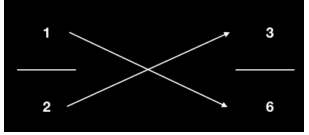
Example 2:
Check if two fractions \(\frac { 2 }{ 5 } \) and \(\frac { 4 }{ 10 } \) are equivalent?
Solution:
Given two fractions are \(\frac { 2 }{ 5 } \) and \(\frac { 4 }{ 10 } \).
With the help of cross multiplication, we have to multiply the numerator value of the first fraction with the denominator value of the second fraction and vice versa.
Therefore, 2 * 10 = 20 and 5 * 4 = 20
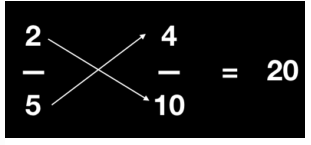
Hence, both the product values are similar, both the fractions are equivalent.
Example 3:
Check if two fractions \(\frac { 5 }{ 11 } \) and \(\frac { 15 }{ 33 } \) are equivalent?
Solution:
Given two fractions are \(\frac { 5 }{ 11 } \) and \(\frac { 15 }{ 33 } \).
With the help of cross-multiplication, we can find if the fractions are equivalent
In the first step, we have to multiply the numerator of the 1st fraction with the denominator of the second fraction
5 * 33 = 165
In the second step, we have to multiply the numerator of the 2nd fraction with the denominator of the 1st fraction
11 * 15 = 165
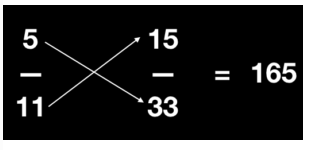
Hence, both the fractions have the similar values, they are said to be equivalent fractions.
Example 4:
Check if the fractions \(\frac { 3 }{ 7 } \) and \(\frac { 7 }{ 11 } \) are equivalent?
Solution:
Given two fractions are \(\frac { 3 }{ 7 } \) and \(\frac { 7 }{ 11 } \).
With the help of cross multiplication, we can find if the fractions are equivalent.
In the first step, we have to multiply the numerator of the 1st fraction with the denominator of the second fraction
3 * 11 = 33
In the second step, we have to multiply the numerator of the 2nd fraction with the denominator of the 1st fraction
7 * 7 = 49
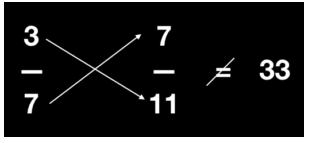
Hence, both the result values are not equal, the fractions are not equivalent.
Example 5:
Check if the fractions \(\frac { 3 }{ 4 } \) and \(\frac { 6 }{ 8 } \) are equivalent?
Solution:
Given two fractions are – \(\frac { 3 }{ 4 } \) and \(\frac { 6 }{ 8 } \).
With the help of cross multiplication, we can find if the fractions are equivalent
In the first step, we have to multiply the numerator of the 1st fraction with the denominator of the second fraction
3 * 8 = 24
In the second step, we have to multiply the numerator of the 2nd fraction with the denominator of the 1st fraction
6 * 4 = 24
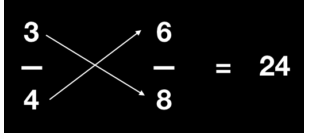
Hence, both the fractions have the similar values, they are said to be equivalent fractions.
Frequently Asked Questions on Equivalent Fractions
1. What are the examples of equivalent fractions?
The example of equivalent fractions are
\(\frac { 3 }{ 4 } \) and \(\frac { 12 }{ 16 } \)
\(\frac { 1 }{ 5 } \) 1/5 and \(\frac { 5 }{ 25 } \) 5/25
\(\frac { 1 }{ 3 } \) 1/3 and \(\frac { 3 }{ 9 } \) 3/9
\(\frac { 2 }{ 4 } \) 2/4 and \(\frac { 3 }{ 6 } \) 3/6
2. How many equivalent fractions does \(\frac { 5 }{ 10 } \) have?
After the simplification, \(\frac { 1 }{ 2 } \) is the final fraction of \(\frac { 5 }{ 10 } \). Therefore, the equivalent fractions of \(\frac { 5 }{ 10 } \) are \(\frac { 1 }{ 2 } \), \(\frac { 2 }{ 4 } \), \(\frac { 3 }{ 6 } \), \(\frac { 4 }{ 8 } \).
3. What are the uses of equivalent fractions?
Equivalent fractions will help us to subtract or ass fractions of unlike denominators and also it makes it easy to understand how to simplify fractions. People can easily visualize each fraction size and its relation.